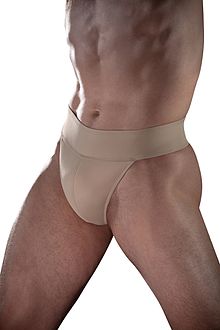Dance belt
This article needs additional citations for verification. (March 2023) |

A dance belt is a kind of specialized undergarment commonly worn by male ballet dancers to support their genitals. Most are similar in design to thong underwear.[1]
Dance belts were developed in the early 1900s for male dancers to wear during training and performances
- to keep the genitals from moving
- to present a smooth and inexplicit contour to onlookers, especially under bright stage lighting.
A dance belt resembles a thong undergarment in design but has a wider waist belt, also to give a smooth appearance. From the back, the belt is connected by a narrow piece of elasticized fabric to the bottom of a front triangular panel. This strip is concealed between the buttocks in what is sometimes called a "T-back" design. Other styles have a seat, similar to briefs, but under a tight costume, they risk causing "panty lines".
Unlike an athletic supporter (jock strap), it lacks a pair of elasticized straps from the pouch back out to the upper thighs. The Japanese fundoshi shares some similarities with a dance belt.
The dance belt is usually "flesh coloured" - beige, dark brown or black - to make it less visible under a costume, or white, when it can be dyed to any color. Some dances are performed wearing a dance belt alone.
A very few makers of dance belts provide instructions on wearing them comfortably.[2]
The support pouch can be made of two layers of spandex fabric (or similar); or there may be a thin layer of padding to make the front smoother. The front is generally seamless.
For other activities[edit]
Dance belts may also be worn for other public dance styles, and for other activities involving skin-tight costumes, such as figure skating, trapeze, acting, cosplay and equestrian sports. In those, especially dressage or other English riding disciplines, the purpose is protection, since trotting in a deep saddle can hurt or injure the testicles, particularly if the rider is inexperienced or has lost balance. The dance belt holds them up out of harm's way.[1]
See also[edit]
References[edit]
- ^ a b "The Complete Guide to Dance Belts". Dr. Dancebelt's Guide - Dance belts for horseback riding. Dancebelt.info. Retrieved 3 May 2022.
- ^ "How to Wear a Dance Belt". Dance Jox. 31 August 2013.
External links[edit]
 Media related to Dance belts at Wikimedia Commons
Media related to Dance belts at Wikimedia Commons
